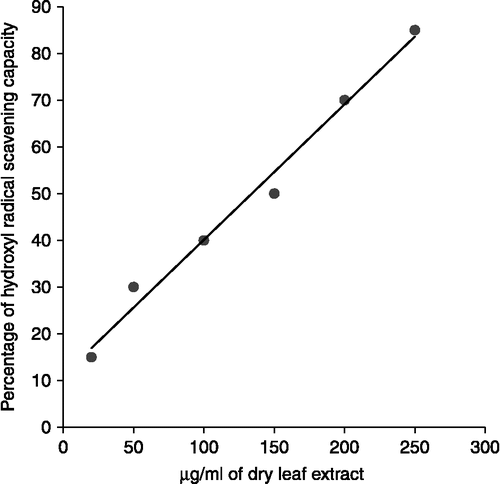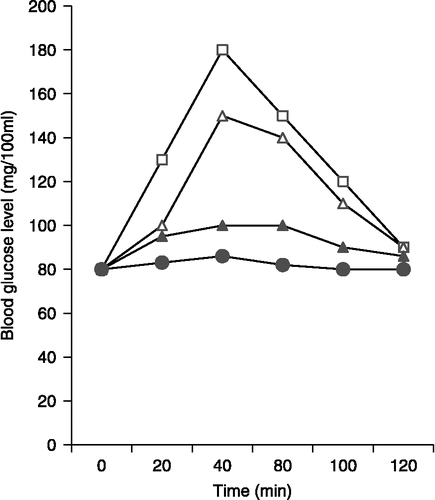Figures & data
Table I. Saponarin content of Tinospora cordifolia leaves.
Figure 2. Hydroxyl radical scavenging capacity of dried aqueous extract of Tinospora cordifolia leaves. Methods for preparation of dried leaf extract and determination of hydroxyl radical scavenging activity were as described in text.

Figure 3. Determination of Ki of saponarin on maltase and sucrase. Dixon plot (1/V vs I) for inhibition of saponarin on activities of intestinal maltase (a), intestinal sucrase (b), fungal maltase (c) and fungal sucrase (d). Saponarin (10–80 μM) was added against different concentrations (0.5–4 mM) of maltose [S]. Enzyme activities were assayed by the method as described in text.
![Figure 3. Determination of Ki of saponarin on maltase and sucrase. Dixon plot (1/V vs I) for inhibition of saponarin on activities of intestinal maltase (a), intestinal sucrase (b), fungal maltase (c) and fungal sucrase (d). Saponarin (10–80 μM) was added against different concentrations (0.5–4 mM) of maltose [S]. Enzyme activities were assayed by the method as described in text.](/cms/asset/34cd878b-96b2-409e-96c5-9e79ed26e970/ienz_a_333474_f0003_b.gif)
Figure 4. Determination of ki′ of saponarin on maltase and sucrase. S/V vs I plot for inhibition of saponarin on activities of intestinal maltase (a), intestinal sucrase (b), fungal maltase (c) and fungal sucrase (d). Saponarin (10–80 μM) was added against different concentrations (0.5–4 mM) of maltose [S]. Enzyme activities were assayed by the method as described in text.
![Figure 4. Determination of ki′ of saponarin on maltase and sucrase. S/V vs I plot for inhibition of saponarin on activities of intestinal maltase (a), intestinal sucrase (b), fungal maltase (c) and fungal sucrase (d). Saponarin (10–80 μM) was added against different concentrations (0.5–4 mM) of maltose [S]. Enzyme activities were assayed by the method as described in text.](/cms/asset/eaf921fe-6f62-4520-a97f-7e4d01a09810/ienz_a_333474_f0004_b.gif)
Table II. Saponarin inhibitor constant (μM) for maltases and sucrases of different origins.
Figure 5. Hypoglycemic activity of saponarin. Saponarin (20–80 mg/kg body weight) was orally administered to the SD rats. Five minutes later, maltose (2 gm/kg body weight) was fed orally to the rats and the effect on blood glucose was recorded till 120 min. Controls were fed orally with equal volume of physiological normal saline. Results presented were mean values obtained from three sets of identical experiments. -▪- Control; -△- 20 mg/kg; -▴- 40 mg/kg; -•- 80 mg/kg.

